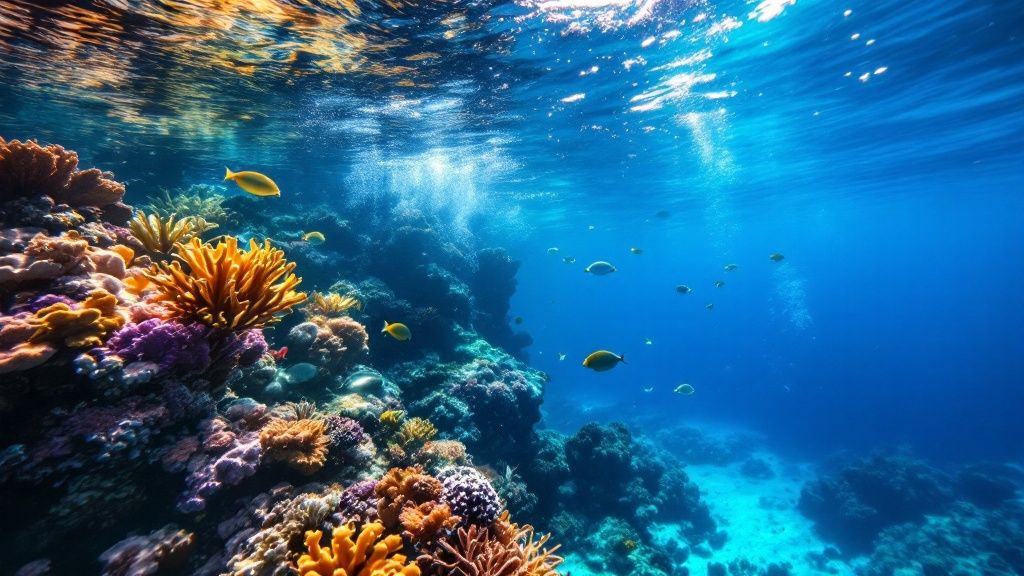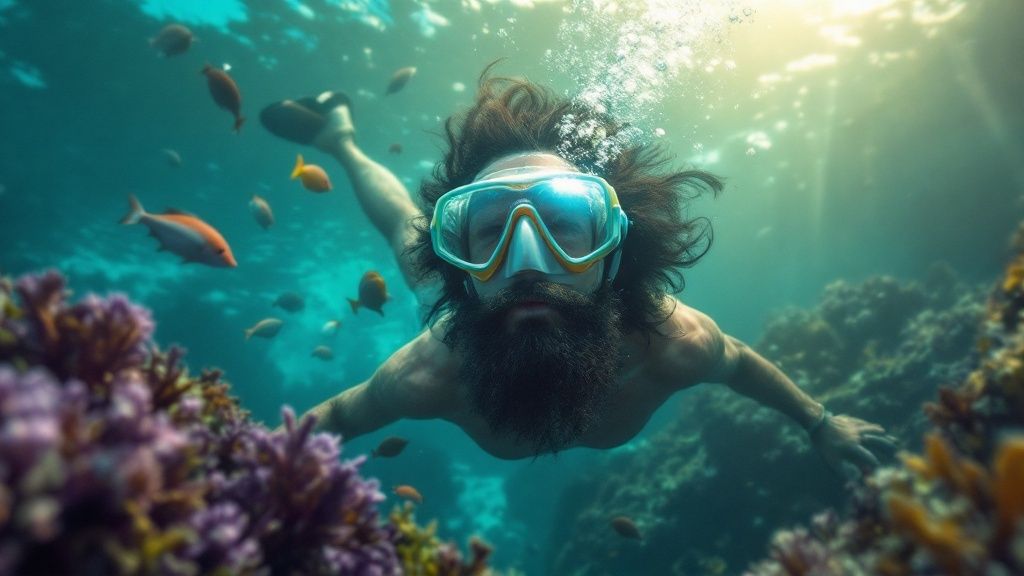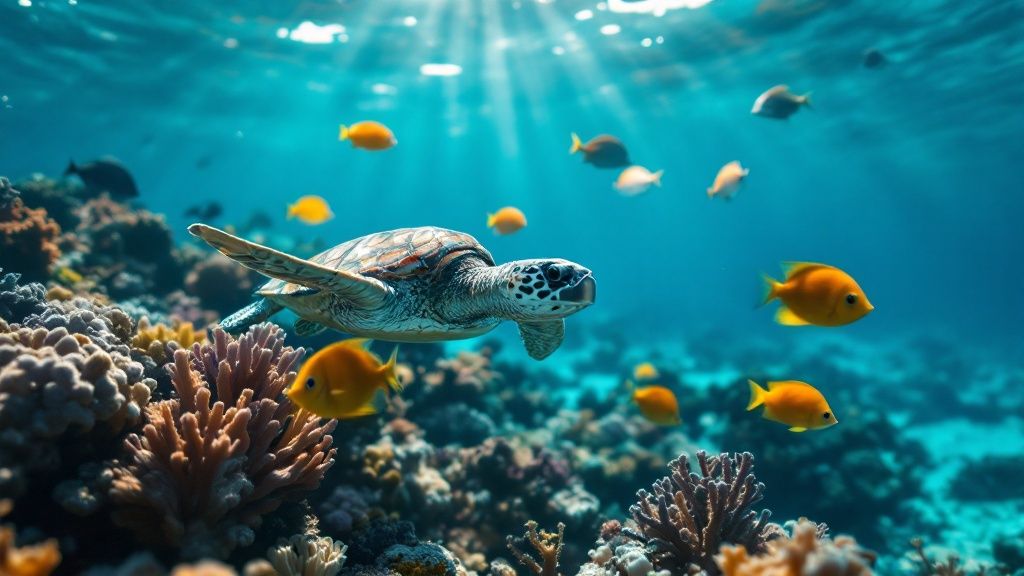Big Island Captain Cook Snorkeling: Discover Hawaii
- Kona Snorkel Trips
- Apr 10
- 11 min read
Why Captain Cook Is Hawaii's Ultimate Underwater Playground

Captain Cook isn't just a name on the map. It's a portal to an underwater world unlike any other in Hawaii. What sets this area apart for snorkeling? It's a unique combination of factors: incredible water clarity, sheltered bays, and distinctive geological features. These elements create a thriving ecosystem perfect for exploration beneath the surface.
Kealakekua Bay, in particular, often boasts visibility exceeding 100 feet. This exceptional clarity lets snorkelers truly appreciate the vibrant coral reefs and observe diverse marine life with incredible detail. The bay's protected nature also contributes to the calm, clear water. Shielded from strong ocean currents, Kealakekua Bay offers a tranquil haven for marine species and easy snorkeling, particularly for beginners.
The unique lava formations and underwater landscape have created various habitats supporting a wide range of marine life. These underwater structures provide shelter and breeding grounds for numerous species, boosting the area's biodiversity. This means every snorkeling trip in Captain Cook can be a new adventure, filled with unexpected sights and captivating discoveries.
Historical events have also shaped the appeal of snorkeling in the Captain Cook area of the Big Island. Captain James Cook's arrival in Hawaii in 1778 marked the first time a Westerner landed on the islands, significantly changing the region’s history and introducing it to the world. This eventually led to snorkeling becoming a popular pastime. Today, Kealakekua Bay is a protected Marine Life Conservation District, attracting thousands of snorkelers yearly to its vibrant reefs and diverse marine life. Discover more insights about Captain Cook's historical significance.
Accessibility For All Snorkelers
Big Island Captain Cook snorkeling is remarkably accessible for all skill levels. Whether you're a seasoned pro or a first-timer, the calm, clear waters and abundant marine life offer an unforgettable experience. For beginners, the shallow, protected bays offer a gentle introduction to the underwater world.
More experienced snorkelers can venture further to explore deeper areas and encounter more elusive marine creatures. Underwater photography enthusiasts also find Captain Cook ideal because of the exceptional water clarity and abundance of fascinating subjects. You might be interested in: Our sitemap for more snorkeling adventures. This accessibility, coupled with the area's inherent beauty, consistently ranks Captain Cook among the best snorkeling destinations.
For a truly immersive experience, consider guided tours from reputable operators like Captain Cook Snorkeling Tours, Kona Honu Divers, and for a unique adventure, Manta Ray Night Snorkels. You can also explore Kealakekua Bay on your own with helpful resources from Kona Snorkel Trips.
5 Captain Cook Snorkeling Spots You Can't Miss

Kealakekua Bay, steeped in history and teeming with marine life, is a must-see for snorkelers. But the Captain Cook area offers a variety of other amazing snorkeling locations, each with its own distinct appeal. Let's explore five incredible spots that promise unforgettable underwater adventures.
Kealakekua Bay: A Snorkeler's Paradise
Kealakekua Bay, home to the Captain Cook Monument, is a popular starting point for snorkelers visiting the Big Island. Spinner dolphins often greet visitors, adding an element of wonder. The bay’s vibrant reef is home to a multitude of colorful fish and other marine life. The calm, clear water and diverse sea life make this spot perfect for beginners and seasoned snorkelers alike.
Two Step at Honaunau Bay: Easy Access, Thriving Reef
Two Step, located at Honaunau Bay, is a local favorite known for its easy access points formed by lava rock. This makes it ideal for families and those new to snorkeling. Once you enter the water, you'll be immersed in a vibrant reef ecosystem teeming with yellow tangs and butterflyfish. This area is often less crowded than Kealakekua Bay, allowing for a more relaxed snorkeling experience.
Keei Beach: Secluded Beauty and Coral Gardens
For a more secluded adventure, consider Keei Beach. This hidden gem boasts magnificent coral formations and close-up encounters with diverse marine life. It's a wonderful location for those who prefer a quieter setting. Exploring the underwater trails at Keei Beach, while requiring a bit more effort to reach, offers a truly rewarding experience with untouched natural beauty.
Manini Beach (Pu'uhonua o Honaunau National Historical Park): History Meets Snorkeling
Manini Beach, within Pu'uhonua o Honaunau National Historical Park, offers a unique combination of history and snorkeling. This protected area is rich in cultural significance, featuring ancient Hawaiian structures. The tranquil waters provide exceptional snorkeling opportunities, making it both educational and enjoyable for visitors of all ages.
Southern Reaches of Kealakekua Bay: Beyond the Monument
While the area around the Captain Cook Monument is stunning, the southern reaches of Kealakekua Bay offer even more hidden gems. This often-overlooked area provides superb snorkeling, boasting diverse marine life and vibrant coral gardens. It’s a fantastic option for those seeking a less crowded experience and wishing to explore a different part of the bay. For more snorkeling tips, check out our blog category sitemap.
To help you choose the best spot for your adventure, we've compiled a comparison table of the top 5 snorkeling locations in the Captain Cook area.
Captain Cook Snorkeling Spots Comparison
Location | Marine Life Diversity | Accessibility | Facilities | Best Time to Visit | Crowd Level |
|---|---|---|---|---|---|
Kealakekua Bay | High - diverse reef fish, dolphins | Boat access or moderate hike | Restrooms, kayak rentals | Morning for calm waters | High |
Two Step at Honaunau Bay | High - yellow tangs, butterflyfish | Easy entry via lava rock steps | Limited facilities | All day, tide dependent | Moderate |
Keei Beach | Moderate to High - diverse reef fish, coral formations | Short walk down a dirt path | No facilities | All day, tide dependent | Low |
Manini Beach (Pu'uhonua o Honaunau National Historical Park) | Moderate - reef fish, coral | Easy beach access | Restrooms, cultural exhibits | All day | Moderate |
Southern Reaches of Kealakekua Bay | High - diverse reef fish, coral gardens | Kayak or boat access | No facilities | Morning for calm waters | Low |
As this table shows, each location offers unique benefits and considerations.
Each of these locations provides unique snorkeling experiences, from easy-access spots perfect for beginners to secluded coves ideal for experienced snorkelers. Remember to consider the time of day, current conditions, and your own comfort level when planning your snorkeling adventure. Always respect the environment and practice responsible snorkeling to preserve these precious underwater ecosystems.
Underwater Encounters: Captain Cook's Marine Marvels

Big Island Captain Cook snorkeling offers a remarkable look into a vibrant underwater world. It’s more than just dipping below the surface; it's a chance to connect with marine life. The area boasts incredible biodiversity, and with some preparation, you can transform your snorkeling experience from passive observation to active appreciation.
Identifying the Reef's Inhabitants
Kealakekua Bay and its surrounding waters are teeming with life, home to over 200 species of tropical fish. Learning to identify these colorful creatures adds a new layer of enjoyment to your snorkeling adventure. The Humuhumunukunukuapua'a, Hawaii's state fish, is a frequent sight, easily recognizable by its unique shape and bright colors.
Also, be sure to look for the various angelfish that call this area home. From the majestic Emperor Angelfish to the more elusive Potter's Angelfish, these beautiful fish add to the vibrant tapestry of the reef.
Encounters With Gentle Giants
Green sea turtles are permanent residents of these waters, gracefully gliding through the coral gardens. Understanding their habits and preferred locations will increase your likelihood of a memorable encounter. Respectful viewing practices are crucial for a positive interaction.
Maintaining a safe distance and avoiding sudden movements ensures you don't disturb these gentle giants. This allows for a more natural and rewarding experience for both you and the turtles.
Dolphins and Seasonal Visitors
Spinner dolphins are regular visitors to Kealakekua Bay, often putting on a spectacular show with their acrobatic leaps and spins. Early mornings are typically the best time to witness these playful creatures. The marine wonders of Kealakekua Bay extend beyond the resident population.
Seasonal visitors add another element of excitement to your snorkeling trip. Spotted eagle rays, with their striking markings, are a common sight, gracefully moving through the water. Manta rays, the ocean's gentle giants, are also seasonal visitors, offering incredible encounters, especially during night dives or specialized tours like those offered by Manta Ray Night Snorkels.
During the winter months, you might even spot humpback whales in the area, adding another dimension to the rich marine life. You might be interested in: Our product sitemap for snorkeling gear. Learning about the habits of these seasonal visitors changes your snorkeling trip from simple sightseeing to meaningful wildlife appreciation, creating memories that will last a lifetime. Enhance your experience with guided tours from reputable operators like Kona Honu Divers or explore Kealakekua Bay on your own. For a more structured adventure, consider Captain Cook Snorkeling Tours, offering a variety of excursions.
Planning Your Dream Big Island Captain Cook Snorkeling Trip

Planning a truly unforgettable snorkeling adventure in Big Island's Captain Cook starts with thoughtful preparation. This includes considering the ideal time to visit, necessary gear, transportation options, where to stay, and – crucially – safety precautions.
Choosing the Right Season
The optimal time for snorkeling in Captain Cook depends on what you're looking for. Summer (May-September) boasts calmer waters and superb visibility, perfect for those new to snorkeling. Winter (December-April), however, offers the magical opportunity to witness humpback whales, though seas can be rougher. If calm conditions are your priority, a summer trip is recommended. Also, keep in mind that summer months tend to attract larger crowds.
Gear Up for Adventure
Bringing your own snorkeling gear versus renting locally is a decision based on convenience and budget. Kona offers numerous high-quality rental options. However, having your own gear ensures a comfortable fit and familiarity, allowing you to fully immerse yourself in the experience without the distraction of adjusting to unfamiliar equipment.
Transportation Logistics
Reaching Captain Cook's snorkeling sites from Kona involves navigating winding coastal roads. A rental car provides flexibility, but parking can be scarce near popular spots. Think about using ride-sharing services like Uber or Lyft or joining guided tours for a hassle-free journey. Guided tours often include transportation, eliminating parking worries altogether.
Accommodation Strategies
Where you choose to stay can significantly enhance your snorkeling trip. Oceanfront properties often offer direct access to the reef, maximizing your snorkeling time. However, budget-friendly choices strategically located near popular sites can be equally convenient, allowing you to maximize your time in the water without overspending. The economic impact of snorkeling on the Big Island is notable, with half-day tours averaging $85 to $193.75 per person. These tours support local businesses and vital conservation efforts. Learn more about pricing and tours here.
Safety First: Big Island Snorkeling Precautions
Big Island waters have distinct characteristics. Grasping current patterns and recognizing potential hazards linked to volcanic coastlines is essential. Always check local conditions before entering the water, and prioritize safety by snorkeling with a buddy. This is fundamental for a safe and enjoyable experience. For more detailed safety information, consider checking Our store categories sitemap.
By addressing these planning aspects, you'll be well-prepared for an exceptional snorkeling adventure in Captain Cook. Careful preparation ensures a truly memorable experience exploring the underwater wonders. For further snorkeling adventures, check out these established operators: Captain Cook Snorkeling Tours, Kona Honu Divers, and Manta Ray Night Snorkels. You can also discover Kealakekua Bay on your own.
Guided vs. Independent Big Island Captain Cook Snorkeling
Planning a snorkeling trip to Captain Cook, Big Island? One of the first decisions you'll face is whether to join a guided snorkeling tour or explore independently. Each option offers a unique set of advantages and disadvantages, catering to different budgets, experience levels, and desired levels of adventure. Let's explore each option to help you make the best choice for your Big Island snorkeling adventure.
The Perks of Professional Guidance
Guided tours offer several benefits, especially for first-timers or those seeking a more structured experience. One major perk is access to remote locations, like the Captain Cook Monument. This historical site is reachable only by boat or a challenging hike. Reputable tour operators, such as Captain Cook Snorkeling Tours, handle the logistics, allowing you to focus on enjoying the vibrant underwater scenery.
Local guides bring invaluable expertise. They offer insights into marine life behavior, identify the best snorkeling spots, and share fascinating stories about the area’s history. They might point out a well-camouflaged octopus or explain the ecological importance of the coral formations. This elevates your experience from simple observation to a richer understanding of the marine environment.
Finally, guided tours offer curated experiences. Specialized excursions, such as Manta Ray Night Snorkels, focus on specific marine life encounters that you wouldn’t be able to arrange on your own. This provides a unique and memorable experience.
The Freedom of Independent Exploration
Independent exploration provides a different kind of thrill: freedom and adventure. You set your own pace, explore areas that spark your curiosity, and enjoy the tranquility of the ocean at your own rhythm. Locations like Kealakekua Bay offer easy access points and clearly marked areas perfect for independent snorkeling.
This approach is typically more budget-friendly. You're responsible only for equipment rental and transportation, unlike the bundled cost of a guided tour. For experienced snorkelers confident in their abilities, this independence is often preferred.
However, independent snorkeling requires more pre-trip planning. You'll need to research snorkeling locations, secure rental gear from places like Kona Honua Divers, and arrange your own transportation. You are also solely responsible for your own safety.
To help you weigh your options, let's compare the two approaches in a detailed table:
To help you choose the right fit for your adventure, we've summarized the key differences between guided tours and independent snorkeling in the following table:
Factor | Guided Tours | Independent Exploration |
|---|---|---|
Access to Locations | Access to remote areas, including the monument | Limited to accessible areas by shore or kayak |
Expertise | Local guides provide insights and enhance knowledge | Self-reliant; requires prior research |
Convenience | Transportation and gear typically included | Requires personal arrangements |
Cost | Higher due to inclusion of services | Lower, only equipment and transport costs |
Flexibility | Fixed itinerary | Complete freedom to explore at your own pace |
Safety | Guided by professionals with safety protocols | Solely responsible for personal safety |
This table highlights the trade-offs between the convenience and expertise of guided tours and the freedom and affordability of independent exploration.
Whether you choose the structured guidance of a tour or the independent thrill of exploring on your own, the captivating underwater world of Captain Cook awaits. Consider your priorities, budget, and experience level to make the best choice for an unforgettable snorkeling trip.
Protecting Paradise: Responsible Captain Cook Snorkeling
The underwater world around Captain Cook is a truly special place, a delicate ecosystem teeming with life. But this vibrant world needs our help to stay healthy. Even small actions by snorkelers can impact these fragile coral reefs and the creatures that call them home. By understanding the challenges this environment faces, and taking responsible steps, we can help preserve this amazing snorkeling destination for years to come.
Understanding the Challenges
Hawaii's coral reefs face many dangers, from the effects of climate change to the impact of tourism. One major threat is coral bleaching, which happens when rising ocean temperatures stress the coral. Just like a flower wilting in the sun, bleached coral loses its color and may eventually die. Another serious problem is physical damage caused by snorkelers touching or stepping on the coral. Even what seems like light contact can break or injure these slow-growing animals and disrupt the entire reef.
Responsible Snorkeling Practices
Making the most of your snorkeling adventure while protecting the environment starts with being informed and making conscious choices. These simple tips will help protect the reef and ensure a great snorkeling experience:
Maintain a Safe Distance: Admire the marine life without getting too close. Resist the urge to touch or chase them. Keep a respectful distance from the reef itself to avoid any accidental bumps. Think of yourself as a polite visitor in their underwater world.
Don't Feed the Fish: Feeding fish can disrupt their natural diets and upset the balance of the reef’s ecosystem. It can also encourage fish to become aggressive or overly reliant on humans for food.
Use Reef-Safe Sunscreen: Many common sunscreens have chemicals that harm coral. Look for reef-safe options, usually made with minerals, to lessen your environmental impact.
Choose Eco-Conscious Operators: Support tour companies like Captain Cook Snorkeling Tours that prioritize sustainability. Choosing responsible operators contributes to a healthier ocean.
Proper Fin Technique: Be careful with your fin kicks. Avoid stirring up the sand or hitting the reef. Practice smooth, controlled kicks to minimize disturbance.
Preservation Efforts and Your Role
Hawaii's Marine Life Conservation Districts, which include Kealakekua Bay, have been vital in protecting these underwater treasures. These special areas have rules designed to limit human activity and help maintain thriving reefs. Local community groups also play a big part in these efforts, organizing beach cleanups, coral planting projects, and educational programs to raise awareness and encourage everyone to protect the reef.
You can make a difference, too. By following responsible snorkeling guidelines and supporting eco-friendly tourism, you’re part of the solution. Learn more about our efforts by reading our member profiles. When you understand your connection to this ecosystem, your appreciation for the underwater world grows, and you contribute to ensuring Big Island Captain Cook snorkeling stays amazing for everyone.
Book your responsible snorkeling trip with Captain Cook Snorkeling Tours and discover the beauty of Kealakekua Bay: Captain Cook Snorkeling Tours
